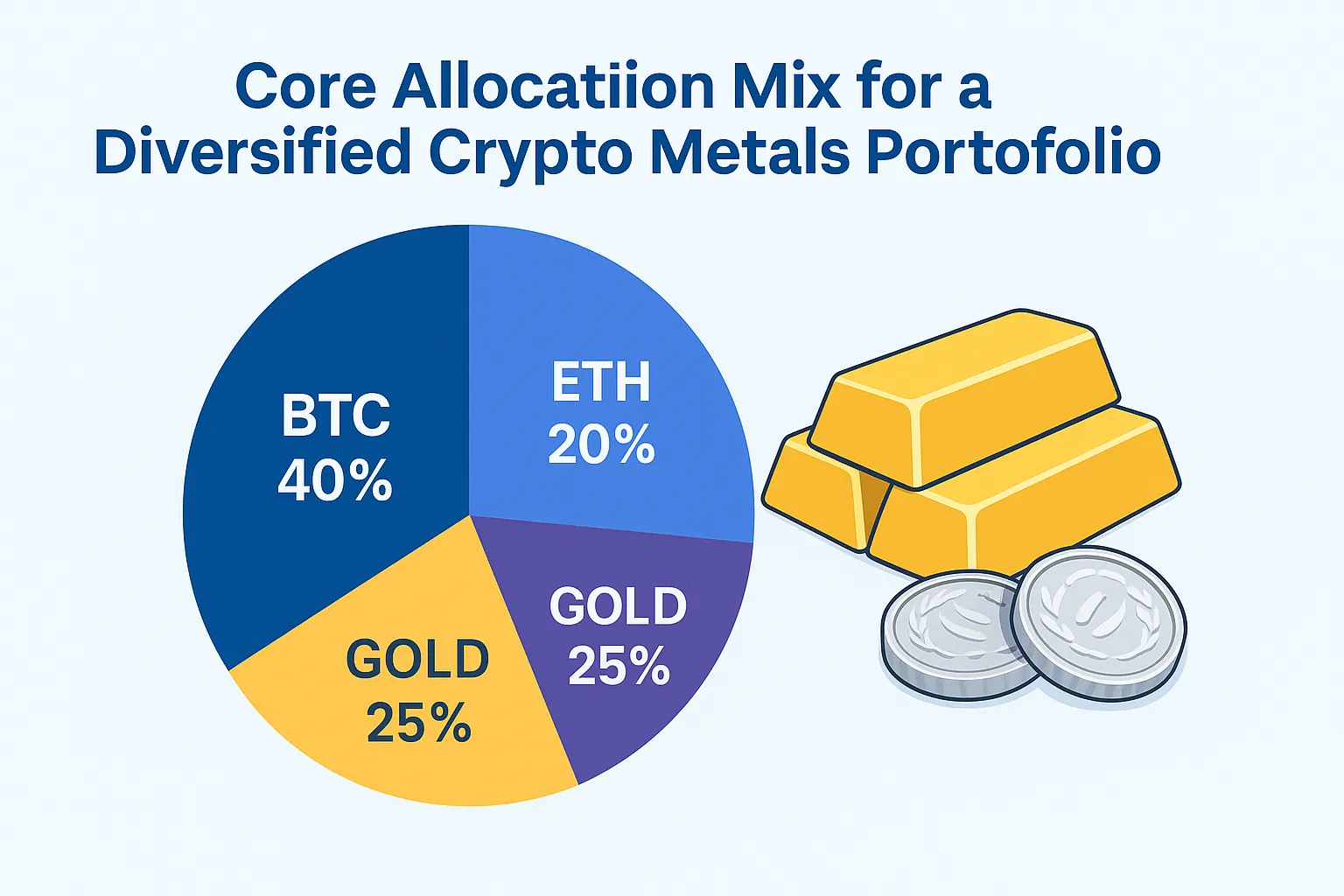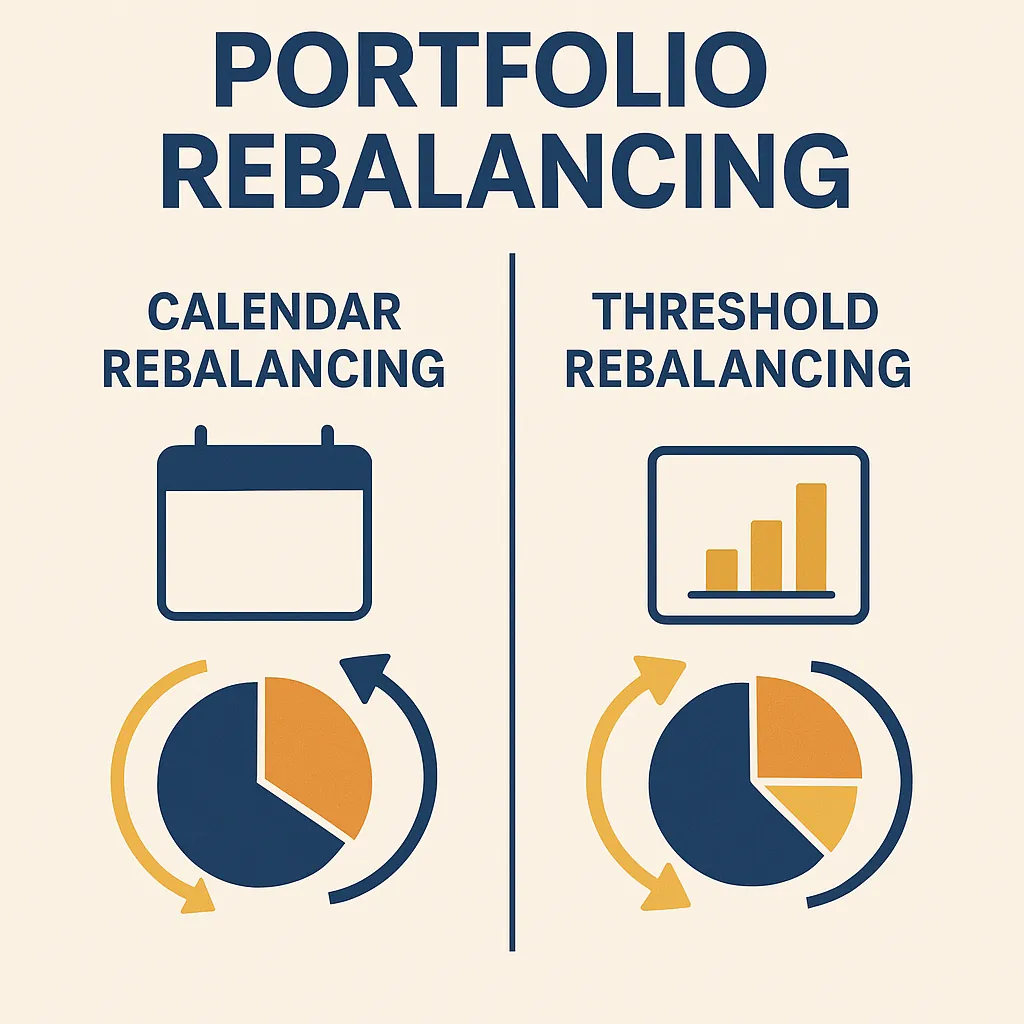
9 Essential Steps to Build a Diversified Crypto and Metals Portfolio
Evergreen • Portfolio Construction
This step-by-step guide shows you how to structure a diversified crypto metals portfolio that blends growth potential from digital assets with the defensive qualities of precious and industrial metals. You’ll get a practical, rules-based framework for balanced portfolio strategy, clear portfolio rebalancing tips, and risk-first playbooks for crypto and gold investing. Throughout, we’ll compare metals vs crypto diversification approaches and outline safe investing strategies you can execute immediately.
🔎 Quick Summary — What You’ll Learn in 9 Steps
- Allocation rules: Right-sizing crypto vs. metals to reduce drawdowns while preserving upside in a diversified crypto metals portfolio.
- Asset selection: How to mix Bitcoin/Ethereum with gold, silver, and select battery metals using ETFs, spot exposure, and custodial options.
- Risk controls: Volatility bands, dynamic hedges, and safe investing strategies tailored to crypto cycles and metals seasonality.
- Maintenance: Calendar- and threshold-based portfolio rebalancing tips that enforce discipline in a balanced portfolio strategy.
We’ll demonstrate how metals vs crypto diversification can smooth returns, why crypto and gold investing often hedge macro shocks differently, and how to codify a balanced portfolio strategy with explicit portfolio rebalancing tips. Each step emphasizes safe investing strategies that prioritize risk-adjusted outcomes.
New to multi-asset construction? Review our primers: Fundamentals of Stock Market Investing, Evergreen Stock Trading Rules, and Stock Market Predictions 2026.
📝 Step 1 — Define Goals & Risk for a Diversified Crypto Metals Portfolio
Every successful diversified crypto metals portfolio begins with clarity: What is the purpose of this allocation? Is it to protect wealth against inflation, to grow capital aggressively, or to smooth out volatility with a balanced portfolio strategy? Your answer to these questions will shape your exposure to both crypto and metals.
Key goal-setting principles include:
- ⏳ Time horizon: Short-term traders will allocate differently than those holding for decades.
- 📉 Risk tolerance: Crypto assets may swing 50% in a year; metals like gold or silver move far less.
- ⚖️ Portfolio balance: Metals hedge against fiat debasement, while crypto offers asymmetric growth.
Aligning these choices early avoids costly mistakes later, and ensures that your safe investing strategies match your real-world tolerance.
💰 Step 2 — Build the Core: Crypto and Gold Investing
The “core” of any diversified crypto metals portfolio rests on pairing digital assets with time-tested metals. Crypto and gold investing serve as complementary forces: Bitcoin and Ethereum provide innovation-driven upside, while gold and silver deliver monetary safety and liquidity.
Suggested core allocations:
- Bitcoin (BTC): A store-of-value narrative and first-mover advantage make it the anchor of the crypto side.
- Ethereum (ETH): Smart contract utility and adoption justify a secondary position.
- Gold: A proven hedge against inflation, sovereign debt risks, and currency crises.
- Silver: Offers industrial demand exposure plus precious metal stability.
This mix creates resilience: when crypto stumbles, gold often stabilizes returns; when metals lag, crypto may deliver growth. That synergy is why metals vs crypto diversification is so powerful.

For more on foundational asset roles, see Ethereum Price Prediction 2025 and Gold Price Forecast 2026.
⚡ Ready to build a resilient base? Explore our research and watchlists for both crypto and gold investing opportunities that fit a balanced portfolio strategy.
View Our Latest Watchlist →🛰️ Step 3 — Add Satellites: Battery Metals, Stablecoins & Uncorrelated Edges
With the core established, your diversified crypto metals portfolio benefits from carefully chosen “satellite” positions. These are smaller, higher-conviction ideas that can enhance returns without overwhelming the balanced portfolio strategy. In practice, satellites often include select battery metals exposure, high-quality stablecoins for dry powder, and occasionally uncorrelated assets that dampen drawdowns.
Battery Metals Satellites
Battery metals can complement crypto and gold investing by tying part of your portfolio to the energy transition. Think of targeted ETFs or diversified producers rather than single, speculative juniors. This keeps your safe investing strategies intact while leaving room for upside.
- 🔋 Lithium & Nickel: Core inputs for high-energy-density batteries; add selectively to keep metals vs crypto diversification balanced.
- 🧪 Cobalt & Manganese: Smaller weights due to jurisdiction and substitution risks; use diversified vehicles where possible.
- ✏️ Graphite: The anode workhorse—use broad funds to mitigate single-project risk.
Stablecoins as Dry Powder
Maintaining a stablecoin sleeve (held with reputable, transparent issuers and in multiple wallets/custodians) supports your portfolio rebalancing tips by providing immediate liquidity for dips. This cash-like buffer reduces the urge to sell metals or crypto at unfavorable prices, reinforcing safe investing strategies.
Rules for Satellites (Keep It Disciplined)
- Cap exposure: Limit satellites to 10–30% of the portfolio, depending on risk tolerance and time horizon.
- Position sizing: Start small (1–3% per theme) and scale on strength to protect the balanced portfolio strategy.
- Event-driven adds: Deploy stablecoin reserves on volatility spikes, then rebalance back to targets.
Deepen your research with these resources: Silver Market Forecast 2026, Ethereum Price Prediction 2025, and Find Winning Stocks Using a Stock Screener.
⚖️ Step 4 — Balanced Portfolio Strategy: Model Allocations & Guardrails
Allocation is where your plan becomes a repeatable process. Below are three model blends you can use to shape a diversified crypto metals portfolio. Each includes explicit guardrails and portfolio rebalancing tips so the plan is easy to maintain.
Model A — Conservative Income Focus
- 30–40% Gold/Silver (via low-cost ETFs or vaulted products)
- 15–25% Broad Battery Metals (diversified fund)
- 10–20% Bitcoin/Ethereum (spot or physically backed vehicles)
- 10–20% Short-duration Treasuries/High-grade cash equivalents
- 5–10% Stablecoins (multiple custodians)
Rationale: Prioritizes capital preservation with metals leading; crypto sized for asymmetric upside within safe investing strategies.
Model B — Balanced Core Growth
- 25–35% Gold/Silver
- 15–25% Battery Metals basket
- 20–30% Bitcoin/Ethereum
- 5–15% Stablecoins (for tactical adds)
- 5–10% Uncorrelated assets (e.g., managed futures)
Rationale: Classic balanced portfolio strategy—keeps metals vs crypto diversification even, with dry powder ready for dislocations.
Model C — Growth-Oriented (Higher Volatility)
- 20–30% Gold/Silver
- 10–20% Battery Metals basket
- 30–45% Bitcoin/Ethereum
- 5–10% Stablecoins
- 0–10% Opportunistic themes (staking yield, miners/royalties)
Rationale: Tilts toward crypto growth while keeping metals meaningful for defense. Fit for long horizons and strong nerves.
Guardrails You Can Automate
- Ceilings & Floors: Set min/max bands per sleeve. Example: BTC 15–35%, Gold 20–40%.
- Threshold Rebalancing: If any sleeve deviates ±20% from its target, rebalance at next window.
- Calendar Rebalancing: Quarterly or semiannual trues-ups enforce discipline when markets trend.

Execution Notes (So You Don’t Over-Tinker)
- Use bands, not guesses: Decisions based on rules beat impulsive tinkering—core to safe investing strategies.
- Stage entries: DCA in tranches; reserve stablecoins for opportunistic top-ups.
- Keep fees low: Prefer spot/ETF vehicles with transparent costs; minimize turnover when rebalancing.
Continue your research with Evergreen Stock Trading Rules and Analyst Comparison: Best Stocks to Invest. For risk framing, read Investopedia: Rebalancing.
✅ Lock in a model today and automate your bands. A rules-based balanced portfolio strategy turns volatility into opportunity— the cornerstone of a durable diversified crypto metals portfolio.
Get Our Weekly Allocation Notes →⚙️ Step 5 — Execution Stack: Custody, Brokers & Low-Fee Vehicles
Even the best diversified crypto metals portfolio fails if you execute poorly. Safe, efficient, and cost-aware implementation matters as much as allocation. This is where safe investing strategies begin in practice.
- 🔐 Crypto custody: Use a mix of cold storage for long-term holdings and reputable exchanges for liquidity.
- 🏦 Metals storage: Opt for vaulted gold/silver ETFs or direct custody with trusted custodians.
- 💸 Low-fee vehicles: Select ETFs or spot funds with transparent pricing to protect returns.
- 🧾 Tax awareness: Track cost basis meticulously to simplify Step 8 (tax optimization).
Prioritize platforms with regulatory clarity, multi-factor security, and strong balance sheets. That foundation preserves the integrity of your balanced portfolio strategy.
🔄 Step 6 — Portfolio Rebalancing Tips: Calendar vs Threshold Rules
Portfolio rebalancing tips anchor discipline in a diversified crypto metals portfolio. Without rebalancing, winners run unchecked, losers drag portfolios longer than necessary, and risk drifts away from target.
Calendar Rebalancing
On fixed intervals (quarterly or semiannually), rebalance back to targets regardless of market action. This forces selling high and buying low—an essential safe investing strategy.
Threshold Rebalancing
Trigger rebalancing only when allocations deviate by set bands (e.g., ±20%). This reduces unnecessary trades and transaction costs, aligning with a balanced portfolio strategy.
Many investors blend both: quarterly checks, but only rebalance if a sleeve is outside its band.
🛡️ Step 7 — Safe Investing Strategies: Volatility Bands, Stops & Hedging
Crypto can drop 70% in a cycle; metals can stagnate for years. That’s why safe investing strategies are not optional—they’re core to making a diversified crypto metals portfolio durable.
- 📊 Volatility bands: Set target exposure ranges (e.g., BTC 15–35%, Gold 20–40%). Stay inside them via Step 6’s rebalancing rules.
- ⛔ Stop-loss discipline: Define risk per position (e.g., 1–3% of portfolio) and size trades accordingly.
- 🛡️ Hedging: Use inverses, options, or uncorrelated assets to blunt drawdowns while retaining upside.
The objective isn’t eliminating risk; it’s controlling it so your metals vs crypto diversification plan survives shocks and thrives long term.

Learn more in our guides: Evergreen Stock Trading Rules, Which Broker Should I Go With?, and CME: Hedging Basics.
✅ Put rules first, emotions last. With disciplined portfolio rebalancing tips and robust safe investing strategies, your diversified crypto metals portfolio can endure volatility and compound steadily.
Explore Our Risk-Control Tools →💡 Step 8 — Tax Awareness & Location Optimization
A diversified crypto metals portfolio doesn’t exist in a vacuum—tax regimes heavily influence real returns. Safe investing strategies always factor in after-tax outcomes. Without planning, you may give up 20–40% of gains unnecessarily.
- 📊 Tax lots: Track purchases to sell highest-cost or lowest-cost lots strategically.
- 🌍 Jurisdiction choice: Consider tax-advantaged accounts (IRAs, 401(k)s) for metals ETFs; locate crypto in taxable accounts where long-term treatment applies.
- 🧾 Harvesting: Use losses in one sleeve (e.g., crypto drawdown) to offset gains in another (e.g., metals rally).
With forethought, taxes become another lever in your balanced portfolio strategy, not a drag.
🤖 Step 9 — Automation, Monitoring & Review Cadence
Once built, your diversified crypto metals portfolio should run with minimal friction. Automation enforces discipline and reduces emotional mistakes.
- Rebalancing automation: Use broker/exchange alerts or apps to notify when allocations break thresholds.
- Recurring buys: Dollar-cost average into BTC, ETH, gold, or silver with automated schedules.
- Monitoring cadence: Review monthly for drift, quarterly for rebalancing, and annually for strategy updates.
Automation makes your portfolio rebalancing tips executable without second-guessing, locking in the principles of safe investing strategies.
❓ Frequently Asked Questions
1. Why combine metals and crypto in one portfolio?
Metals vs crypto diversification smooths returns. Metals hedge inflation and systemic risk, while crypto drives asymmetric growth.
2. What’s a safe starting allocation?
Begin with 60–70% metals (gold/silver + ETFs) and 20–30% crypto, adding satellites slowly. This aligns with a balanced portfolio strategy.
3. How often should I rebalance?
Apply our portfolio rebalancing tips: quarterly calendar reviews or threshold triggers at ±20% of target.
4. Are stablecoins safe?
Use only transparent, regulated issuers; spread holdings across multiple custodians. This reinforces safe investing strategies.
5. Should I invest in metals miners too?
Miners offer leverage but also volatility. Limit to satellites unless you have sector expertise.
🏁 Final Verdict
Building a diversified crypto metals portfolio requires more than chasing hot assets—it demands a clear framework. By following these 9 steps, you’ve defined goals, built a core of crypto and gold investing, added satellite exposures, applied a balanced portfolio strategy, enforced portfolio rebalancing tips, and committed to safe investing strategies.
This disciplined approach turns volatility into opportunity. With metals for stability and crypto for growth, your portfolio can compound through multiple market cycles.
📈 Ready to put theory into action? Explore our Penny Stocks Watch List and curated alerts to pair with your diversified crypto metals portfolio.
Get TradeStockAlerts Today →